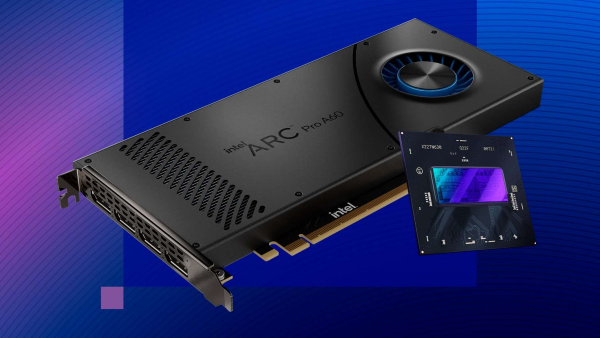Intel Reveals Fastest Arc Pro Workstation GPUs Yet
The new Intel Arc Pro GPUs for desktops and laptops come with double the video memory, PCIe lanes and compute units over models from last year. The planned rollout is part of Intel’s effort to challenge Nvidia and AMD in the GPU market for PCs and data centers.

Intel has introduced the fastest workstation GPUs yet in its Arc Pro A-series lineup, doubling the video memory, memory bandwidth, PCIe lanes and compute units over models launched last year.
The Santa Clara, Calif.-based semiconductor giant said the Arc Pro A60 for desktops will be available from authorized distributors in the “coming weeks” while the Intel Arc Pro A60M will arrive in laptops from OEMs in the “coming months.”
[Related: Intel Makes Cuts To Data Center GPU Road Map, Delays Falcon Shores To 2025]
Meanwhile, HP Inc., Dell Technologies and Lenovo are expected to release workstation desktops with the lower-end Arc Pro A40 in the third quarter.
The new GPUs are best suited for computer-aided design and modeling applications, AI inferencing tasks as well as media processing in “dedicated business environments,” Intel said. Like other Arc GPUs, they come equipped with built-in hardware for real-time ray tracing and machine learning capabilities.
Intel Arc Pro A60, A60M Specs
On the desktop side, the Arc Pro A60 features 12GB of GDDR6 memory, 16 Xe cores, 16 ray tracing units and 16 PCie Gen 4 lanes. Those specifications are double over what is provided in the Arc Pro A40 and A50 models from last year.
According to Intel, this “significant step up in performance” allows the A60 to hit just over 10 teraflops at single precision, which translates to a little over 10 trillion floating point operations per second. By contrast, the A40 and A50 models can only hit just over 5 teraflops at single precision.
The tradeoff: A60 requires significantly more power, consuming 130 watts at peak power in a single slot form factor. Meanwhile, the A50 takes up 75 watts at peak power in a low-profile, dual slot form factor, and the A40 hits 50 watts at peak power in the same form factor as the latter.
On the laptop side, the Arc Pro A60M features 8GB of GDDR6 memory, 16 Xe cores, 16 ray tracing units and 16 PCIe Gen 4 lanes, double that of the Arc Pro A30M. This allows the A60M to hit up to 9.42 teraflops at 65-95 watts of peak power while the A30M can only do 4.2 teraflops at 35-50 watts of peak power.
To entice workstation users away from Nvidia and AMD, Intel said its Arc Pro GPUs are “backed by quarterly driver releases for regular performance optimizations.” The chipmaker added that the GPUs are certified for leading workstation applications such as Autodesk’s AutoCAD and Maya, Dassault Systèmes’ Solidworks, PTC’s Creo and Siemens’ Solid Edge.
The Arc Pro GPUs are optimized too for media and entertainment applications like Blender, plus rendering and ray tracing libraries in the Intel oneAPI Rendering Toolkit, according to the company.
Intel’s Plan To Take On Nvidia And AMD
The planned rollout of the new Arc Pro products is part of Intel’s effort to challenge Nvidia and AMD in the GPU market for PCs and data centers. The company has been expanding its Arc lineup for desktop and laptops since it began rolling out products midway last year.
Intel has also been focused on selling data center GPUs, first with the Intel Data Center GPU Flex Series for media applications last year and then the Intel Data Center GPU Max Series for AI and high-performance computing this year.
Randy Copeland, CEO of Velocity Micro, a Richmond, Va.-based Intel system builder partner, said his company isn’t providing desktops with Intel’s Arc GPUs yet because there hasn’t been any demand.
“We think that Nvidia so far has been a proven solution for customers, and we haven’t had a push to seek another choice,” he said.
While Copeland said he welcomes Intel bringing more competition to the GPU market, the chipmaker’s biggest challenge in his view is that it has yet to release a product that impresses across several metrics.
He acknowledged Intel’s push to win against Nvidia’s lower-end RTX products with a superior price-performance ratio but said that wasn’t enough.
“Intel’s done OK with a metric here or there, but it hasn’t come out with an across-the-board solution that is comparable to AMD or Nvidia,” he said.